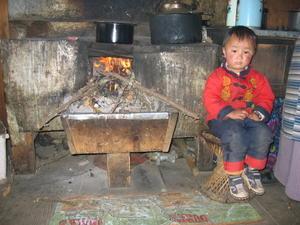Advertisement
Published: July 24th 2006

 Sherpa boy in front of a stove
Sherpa boy in front of a stove
We stopped for tea and snacks at a teahouse in Sanasa village. This boy was quite shy, hiding behind his mother, but was very serious when she told him to pose for a photo.From Namche, we continued climbing up to Tengboche (3867 meters or 12,690 feet). Tengboche has a few teahouses and is a popular stop for trekkers, especially since there is a famous Tibetan Buddhist monastery there.
On the way to Tengboche, we started getting our first major views of the mountains. The views are best in the morning, since the clouds move in and there is often rain in the afternoon at this time of the year. There are some beautiful waterfalls and forests here. As we move higher above the tree lines, we can expect to see fewer forests and more rocks.
We saw a few yak trains on the trail. You normally hear them well in advance because they wear bells around their necks. When you let the yaks pass, it is very important to stand on the inside of the trail. Otherwise, if you are on the edge, the yaks could bump you off the trail. Many trails have steep drop-offs, so this would be a bad thing. Several foreign trekkers have died from these accidents.
We stopped in Sanasa village for tea and in Phunki Tenga village for a late lunch. Near Phunki Tenga, the

 Stupa with prayer flags
Stupa with prayer flags
You see these stupas everywhere in the mountains. This stupa was dedicated to the 50th anniversary of Sir Edmund Hillary and Tenzing Norgay's ascent of Mt. Everest. trail splits: one part goes to the Gokyo Lakes and the other way goes to Everest. This is the last place to stop before the dreaded stone steps and switchbacks. From this point up to Tengboche, there is nowhere to go but up. The sign claims that from there to Tengboche, it takes 2 hours. Ha! Maybe it takes 2 hours for the superhuman Nepalis, but for anyone else, it takes at least 2 ½-3 hours.
The scenery was beautiful, but the last part of the trail was a bastard of a climb up a very steep, endless series of switchbacks. This was one of the most exhausting hikes I’ve ever done. I wish I could have taken a photo of the switchbacks so you could have a better idea of how difficult it was, but this was not possible because the forest was so thick. This trail made the 28 switchbacks at Tiger Leaping Gorge (Yunnan province, China) look like child’s play.
After the switchbacks, the trail kept winding up and around. It was raining and the trail was slippery. It was also starting to get dark outside, so it was hard to see where to step
on the rocky yet muddy trail. We had to break out the flashlights (torches) for the last stumble up to Tengboche.
We finally made it to Tengboche, stopping at the first teahouse we saw when we reached the top of the hill. The woman there was pretty surly and did not seem especially happy that we arrived so late. The place also wasn’t very clean, so I would not recommend it to anyone. Still, it was good to be out of the rain, warming ourselves next to a stove, eating dhal bhat and drinking tea.
Advertisement
Tot: 0.146s; Tpl: 0.011s; cc: 17; qc: 86; dbt: 0.0818s; 1; m:domysql w:travelblog (10.17.0.13); sld: 1;
; mem: 1.2mb

 Sherpa boy in front of a stove
Sherpa boy in front of a stove
 Stupa with prayer flags
Stupa with prayer flags




